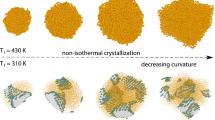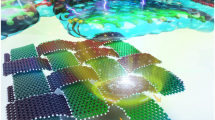Abstract
Selecting high molecular weight has become a quite popular approach for effective tuning of more shish-kebabs in semi-crystalline polymers. However, here, an unusual dependence of shish-kebabs on molecular weight of high-density polyethylene (HDPE) is found under the injection molding with a secondary flow. Characterization with electron microscope and X-ray scattering of the crystal structures reveals that the richest shish-kebabs develop in the HDPE with medium high molecular weight (HMW) chains rather than in the HDPE with more HMW chains. Both macroscopic scales (fluid behaviors related to the intensity of flow) and molecular scales (rheological properties related to orientation and relaxation) need to be overall considered and a physical model has been proposed to explain how the coupling between the chain architectures and the secondary flow field contributes to the unusual phenomenon. The factors, such as molecular parameters, interfaces between dispersed phase, and matrix as well as the properties of filler, profoundly influence both the two scales, which can be employed to tune the morphology related to physical properties. These significant results provide a simple but effective morphology control technique under a secondary flow field.










Similar content being viewed by others
References
Pennings AJ, Kiel AM (1965) Fractionation of polymers by crystallization from solution, III. On the morphology of fibrillar polyethylene crystals grown in solution. Colloid Polym Sci 205:160–162
Keller A, Odell JA (1985) The extensibility of macromolecules in solution; a new focus for macromolecular science. Colloid Polym Sci 263:181–201
Kumaraswamy G, Verma RK, Issaian AM et al (2000) Shear-enhanced crystallization in isotactic polypropylene Part 2. Analysis of the formation of the oriented “skin”. Polymer 41:8931–8940
Roozemond PC, van Drongelen M, Ma Z et al (2015) Self-regulation in flow-induced structure formation of polypropylene. Macromol Rapid Commun 36:385–390
Bashir Z, Odell JA, Keller A (1986) Stiff and strong polyethylene with shish kebab morphology by continuous melt extrusion. J Mater Sci 21:3993–4002. doi:10.1007/BF02431641
Fujiyama M, Wakino T, Kawasaki Y (1988) Structure of skin layer in injection-molded polypropylene. J Appl Polym Sci 35:29–49
Wang K, Chen F, Li Z et al (2014) Control of the hierarchical structure of polymer articles via “structuring” processing. Prog Polym Sci 39:891–920
Lamberti G (2014) Flow induced crystallisation of polymers. Chem Soc Rev 43:2240–2252
Pantani R, Balzano L, Peters GW (2012) Flow-induced morphology of iPP solidified in a shear device. Macromol Mater Eng 297:60–67
Kimata S, Sakurai T, Nozue Y et al (2007) Molecular basis of the shish-kebab morphology in polymer crystallization. Science 316:1014–1017
Phillips AW, Bhatia A, Zhu PW et al (2011) Shish formation and relaxation in sheared isotactic polypropylene containing nucleating particles. Macromolecules 44:3517–3528
Ma Z, Balzano L, van Erp T et al (2013) Short-term flow induced crystallization in isotactic polypropylene: how short is short? Macromolecules 46:9249–9258
Liu D, Tian N, Cui K et al (2013) Correlation between flow-induced nucleation morphologies and strain in polyethylene: from uncorrelated oriented point-nuclei, scaffold-network, and microshish to shish. Macromolecules 46:3435–3443
Zheng GQ, Huang L, Yang W et al (2007) Hierarchical crystalline structure of HDPE molded by gas-assisted injection molding. Polymer 48:5486–5492
Huang HX, Wang B, Zhou WW (2012) Polymorphism in polyamide 6 and polyamide 6/clay nanocomposites molded via water-assisted injection molding. Composites B 43:972–977
Zhang K, Liu Z, Yang B et al (2011) Cylindritic structures of high-density polyethylene molded by multi-melt multi-injection molding. Polymer 52:3871–3878
Wang L, Yang B, Yang W et al (2011) Morphology and mechanical property of high-density polyethylene parts prepared by gas-assisted injection molding. Colloid Polym Sci 289:1661–1671
Zhang Q, Wang L, Xia X et al (2014) Tailoring the crystalline morphologies and mechanical properties of high-density polyethylene parts by a change in the fluid flow pattern under gas-assisted injection molding. J Appl Polym Sci 131(11).
Liu X, Zhang C, Dai K et al (2013) Unexpected molecular weight dependence of shish kebab in water-assisted injection molded HDPE. Polym Adv Technol 24:270–272
Xia XC, Zhang QP, Wang L et al (2014) Extension of the orientation region of high density polyethylene molded by gas-assisted injection molding: control of the thermal field. Polym Int 63:1997–2007
Xia XC, Yang W, Zhang QP et al (2014) Large scale formation of various highly oriented structures in polyethylene/polycarbonate microfibril blends subjected to secondary melt flow. Polymer 55:6399–6408
Shahin MM, Olley RH, Blissett MJ (1999) Refinement of etching techniques to reveal lamellar profiles in polyethylene banded spherulites. J Polym Sci Part B 37:2279–2286
Picken SJ, Aerts J, Visser R et al (1990) Structure and rheology of aramid solutions: X-ray scattering measurements. Macromolecules 23:3849–3854
Winter HH, Mours M (1997) Rheology of polymers near liquid-solid transitions. Neutron spin echo spectroscopy viscoelasticity rheology. Springer, Berlin, pp 165–234
Winter HH (1987) Can the gel point of a cross- linking polymer be detected by the G′- G″ crossover? Polym Eng Sci 27:1698–1702
Elmoumni A, Winter HH, Waddon AJ et al (2003) Correlation of material and processing time scales with structure development in isotactic polypropylene crystallization. Macromolecules 36:6453–6461
Doi M, Edwards SF (1986) The theory of polymer dynamics. Clarendon press, Oxford
Balzano L, Rastogi S, Peters G (2011) Self-nucleation of polymers with flow: the case of bimodal polyethylene. Macromolecules 44:2926–2933
Somani RH, Yang L, Hsiao BS et al (2002) Shear-induced precursor structures in isotactic polypropylene melt by in situ rheo-SAXS and rheo-WAXD studies. Macromolecules 35:9096–9104
Bent J, Hutchings LR, Richards RW et al (2003) Neutron-mapping polymer flow: scattering, flow visualization, and molecular theory. Science 301:1691–1695
van Meerveld J, Peters GW, Hütter M (2004) Towards a rheological classification of flow induced crystallization experiments of polymer melts. Rheol Acta 44:119–134
Zhang QP, Xia XC, He S et al (2015) Tuning crystalline morphology of high density polyethylene by tailoring its molecular weight distribution for coupling with a secondary flow field. Macromol Mater Eng 300:901–910
Xia XC, Zhang QP, Wang L et al (2014) The complex crystalline structure of polyethylene/polycarbonate microfibril blends in a secondary flow field. Macromol Chem Phys 215:1146–1151
Acknowledgements
We express our sincere thanks to the National Natural Science Foundation of China (NNSFC, Grant Nos. 21174092, 51421061) and the Platform Foundation of State Key Laboratory Cultivation Base for Nonmetal Composites and Functional Materials (Grant Nos. 14tdfk04, 14zx7170) for financial support.
Author information
Authors and Affiliations
Corresponding authors
Electronic supplementary material
Below is the link to the electronic supplementary material.
Rights and permissions
About this article
Cite this article
Zhang, QP., Xia, XC., He, S. et al. The coupling relation between chain architectures and secondary flow field determined by an unusual dependence of shish-kebabs on molecular weight of high-density polyethylene. J Mater Sci 51, 2585–2593 (2016). https://doi.org/10.1007/s10853-015-9571-2
Received:
Accepted:
Published:
Issue Date:
DOI: https://doi.org/10.1007/s10853-015-9571-2




